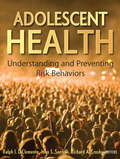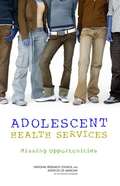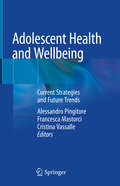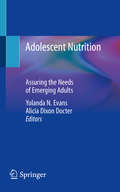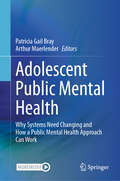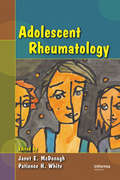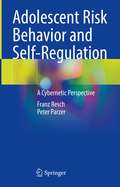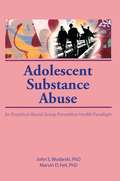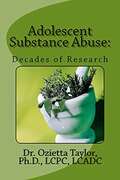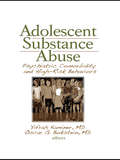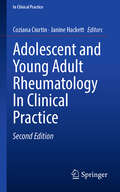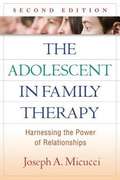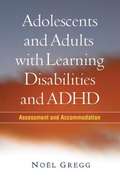- Table View
- List View
Adolescent Health
by Richard A. Crosby John S. Santelli Ralph J. DiclementeThis book covers the developmental and health problems unique to the adolescent period of life. It focuses on special needs and public health programs for adolescents. It offers deep insight into smoking, violence, teen pregnancy, HIV/AIDS, and other problems, along with intervention and prevention strategies."Anyone serious about improving adolescent health should read this book. It spans theoretical and developmental constructs, summaries of evidence-based interventions for adolescent risk behaviors, metrics, and policy recommendations." --S. Jean Emans, MD, chief, Division of Adolescent Medicine, and Robert Masland Jr., chair, Adolescent Medicine, Children's Hospital Boston, and professor of pediatrics, Harvard Medical School"This is the one single text that students can use to study adolescent health. It includes contributions from many of the world's most accomplished researchers to provide learners with cutting edge information to make the study of adolescence understandable and applicable in practical settings." --Gary L. Hopkins, MD, DrPH, associate research professor and director, Center for Prevention Research, and director, Center for Media Impact Research, Andrews University"This textbook presents an excellent balance in weighing the evidence from the risk and the resilience literature, incorporating research in racially and ethnically diverse populations." --Renée R. Jenkins, MD, FAAP, professor, Department of Pediatrics and Child Health, Howard University College of Medicine"This is an engaging, thorough, and thought-provoking statement of our knowledge about adolescence. " --Wendy Baldwin, PhD, director, Poverty, Gender, and Youth Program, Population Council
Adolescent Health Services: Missing Opportunities
by National Research Council Institute of Medicine of the National AcademiesAdolescence is a time of major transition, however, health care services in the United States today are not designed to help young people develop healthy routines, behaviors, and relationships that they can carry into their adult lives. While most adolescents at this stage of life are thriving, many of them have difficulty gaining access to necessary services; other engage in risky behaviors that can jeopardize their health during these formative years and also contribute to poor health outcomes in adulthood. Missed opportunities for disease prevention and health promotion are two major problematic features of our nation's health services system for adolescents. Recognizing that health care providers play an important role in fostering healthy behaviors among adolescents, Adolescent Health Services examines the health status of adolescents and reviews the separate and uncoordinated programs and services delivered in multiple public and private health care settings. The book provides guidance to administrators in public and private health care agencies, health care workers, guidance counselors, parents, school administrators, and policy makers on investing in, strengthening, and improving an integrated health system for adolescents.
Adolescent Health and Wellbeing: Current Strategies and Future Trends
by Alessandro Pingitore Francesca Mastorci Cristina VassalleThis book presents a detailed and updated review of the widespread changes that take place during adolescence, adopting a preventive perspective that reflects physical, social, cognitive, and emotional changes. It addresses a broad range of aspects, including: the preventive programs and their systemic effects; the role of environment in influencing the healthy behaviors of adolescents and young adults; the use of e-Health technology in health and behavioral interventions for adolescents; and the clinical and prognostic implications of primordial prevention in healthy adolescents. All of these elements are subsequently reviewed using a multidimensional approach, in order to offer extensive information on the complex changes that characterize adolescents’ physiological, psychological, and neurobiological development.In addition, the book depicts the preventive strategies currently used in various social settings (school, family, sport club, health policies) aimed not only at reducing lifestyle risk behaviors, but also at improving resilience, happiness, social involvement, self-esteem, and sociability. This update is essential in the light of the fact that, to date, prevention has mainly been directed towards adolescents with physical or mental disorders rather than their healthy peers. As such, the book offers a valuable tool for pediatricians, child and adolescents psychiatrists, and for all professionals involved in Health Promotion and Disease Prevention.
Adolescent Health in the Middle East and North Africa: An Epidemiological Perspective (Global Perspectives on Health Geography)
by Caroline Barakat Fatme Al Anouti Rania DghaimThis 2-volumeset focuses on adolescent health in the Middle East and North Africa region (MENA), and presents the latest research on the health risk behaviours and social behaviours that adolescents from the MENA region engage in. While there has been a surge in peer-reviewed research publications on population health in the MENA region in the last couple of decades, very few books offer a resource to address the diverse negative influences that disproportionately affect adolescents and children in the MENA region, including increased tobacco consumption culture, low emphasis on physical activity, increased sedentary behaviours, weak health policies, and societal issues related to displacement and political conflicts. These books offer a synthesis of current knowledge on adolescent health issues in the MENA region, and aim to provide evidence-informed adolescent health care practices that address current issues related to mental, physical, reproductive and nutritional health. Volume 2 focuses on nutritional and reproductive health in the MENA region, predictive modelling of obesity, determinants of sexual and oral health, HIV, and diabetes. The study will aid health care professionals, policy makers, government organizations and health program planners to assess current policies and practices related to adolescent health in the MENA region, and to identify the best courses of action moving forward.
Adolescent Mental Health in The Middle East and North Africa (Global Perspectives on Health Geography)
by Caroline Barakat Fatme Al AnoutiThis 2-volume set focuses on adolescent health in the Middle East and North Africa region (MENA), and presents the latest research on the health risk behaviours and social behaviours that adolescents from the MENA region engage in. While there has been a surge in peer-reviewed research publications on population health in the MENA region in the last couple of decades, very few books offer a resource to address the diverse negative influences that disproportionately affect adolescents and children in the MENA region, including increased tobacco consumption culture, low emphasis on physical activity, increased sedentary behaviours, weak health policies, and societal issues related to displacement and political conflicts. These books offer a synthesis of current knowledge on adolescent health issues in the MENA region, and aim to provide evidence-informed adolescent health care practices that address current issues related to mental, physical, reproductive and nutritional health. Volume 1 focuses on mental health in the MENA region, the development and implementation of youth friendly public policies, and how to strategize in the age of COVID-19. The study will aid health care professionals, policy makers, government organizations and health program planners to assess current policies and practices related to adolescent health in the MENA region, and to identify the best courses of action moving forward.
Adolescent Nutrition: Assuring the Needs of Emerging Adults
by Yolanda N. Evans Alicia Dixon DocterAdolescents have unique nutritional needs when compared to young children and adults. As youth go through physical, cognitive, and behavioral development, nutrition needs are dynamic and changing. If these needs go undetected and remain unaddressed, the results can derail physical and social maturation and include life-long effects on health. This comprehensive text offers a multidisciplinary perspective on aspects of adolescent nutrition. Using clinical cases, it covers relevant topics related to adolescent health including normal development, chronic health conditions, and complex biopsychosocial dynamics, among others. The first section of the text contains an overview of adolescent nutrition that is further broken down into more specific topics such as developmental nutrition needs, needs of active youth and athletes and media influences on body image. The next section focuses on health disparities such as culturally appropriate care, health equity, international considerations and food insecurity. The following section specifically addresses eating disorders ranging from anorexia and bulimia to binge eating. Finally, the last section covers additional health considerations such as polycystic ovarian syndrome, teen pregnancy, substance use and gender non-conforming youth. Written by experts in the field, this book is a helpful resource for primary care medical providers, registered dietitians/nutritionists (RDN), adolescent medicine specialists, as well as advanced practice nurses, physician assistants, psychologists, licensed social workers, and certified athletic trainers.
Adolescent Pregnancy and Parenting: Reducing Stigma and Improving Outcomes
by Lois T. Flaherty Jean-Victor P. Wittenberg Daniel F. BeckerThis book focuses on the impact of social stigma on adolescents who are at high risk of teen pregnancy. It describes and discusses personal and social factors that predispose them to becoming pregnant and having babies; factors that may subsequently protect or more often, compromise outcomes for both parents and children. The authors, who represent a range of social roles and perspectives, describe the pathways from stigma and its unfounded beliefs about disadvantaged adolescents, to the ways stress burdens teen parents and their children. They note that successful teen parents often go unrecognized and wonder how many more are hobbled by stigma. They recognize the lifespan impacts of stress as described in the ACE studies; stress that has psychological, health and economic implications at individual and social levels. They examine the impact of stigma on parent-child relationships and the attachment system, a stress management system, learned in infancy and persisting into adulthood. The book describes how stigma finds its way into daily interpersonal encounters, systemic policies and practices, and even into healthcare research and services.This sets the stage for an in-depth look at attachment systems within stress management, interventions, and recommendations for professionals whose work is impacted by these issues. Written by experts in the field, this text is the first to cover the current understanding of the risk factors, advanced understanding of developmental issues, and the key intervention tactics for the most positive outcome for adolescent parents and their families.Adolescent Pregnancy and Parenting is an excellent resource for psychiatrists, psychologists, physicians, social workers, educators, researchers, and policy makers working with youths at risk for teenage pregnancies.
Adolescent Public Mental Health: Why Systems Need Changing and How a Public Mental Health Approach Can Work
by Patricia Gail Bray Arthur MaerlenderThis book presents an innovative public mental health model addressing the global crisis of declining mental health among adolescents. Despite the scholarly and public media attention given to post-pandemic adolescent mental health, few published sources present a sustainable, scalable and multisector collaborative solution that includes attention to the social determinants of health, equity, and prevention, together with mental health literacy education and early intervention. This book takes a public health approach to address this need and is inspired by the authors' experience creating and implementing change in adolescent mental health systems. While prevention, together with diagnosis and treatment, are the most effective ways to address mental illness, a systems-level approach has only recently appeared in the applied mental health scientific literature. Unlike cardiovascular disease and cancer, mental health promotion and mental illness prevention have been slow to gain traction in the U.S. However, leading professional associations are beginning to acknowledge the value of a public health approach to adolescent mental health and the need to support public health and mental health intersectoral policies. The concepts presented in this volume draw on three primary systems: public health, mental health and education. The authors present 24 recommendations that are relevant for scholars, practitioners and leaders involved in adolescent mental health. Among the topics covered: U.S. and global adolescent mental health, public health, and school mental health Why a systems change is needed in adolescent mental health How to implement an adolescent public mental health model Taking action with systems change Adolescent Public Mental Health is essential reading for professionals in mental health, public health, social work, and medicine who are interested in moving to a more integrative, multisectoral approach to adolescent mental health. Educators and academic institutions who teach our future leaders will benefit from understanding the new model, which can be seamlessly included in secondary school education. Clinicians, practitioners, school principals and superintendents can adopt the model and collaborative processes, described in the demonstration project, to respond to the mental health challenges they encounter every day.
Adolescent Rheumatology
by Janet E. McDonagh Patience H. WhiteAdolescent Rheumatology is the first single-source text that focuses on how adolescent-specific aspects impact rheumatic conditions and cross references disease-specific information from general rheumatology textbooks. Using a generic, developmental approach to make this book unique, the evidence base is referenced with a clinical and practical app
Adolescent Risk Behavior and Self-Regulation: A Cybernetic Perspective
by Franz Resch Peter ParzerThis book is based on the idea that increasing juvenile risk behaviours – like substance abuse, nonsuicidal self-injury, and antisocial or suicidal behaviour – allow adolescents to fulfill developmental tasks like identity-formation and regulation of self-worth. Narcissistic self-exploitation, mobility tasks, flexibility and the challenges of new media exert social pressure on parental figures, distracting and putting strain on their mental resources, which in turn changes and even destroys the emotional dialogue with their offspring. If children themselves experience neglect and lack of emotional bonding - resulting in a lack of self-regulating capacities – risk behaviours are the consequence. The book combines different views in the psychological, social and metatheoretical domains. It consists of three parts: developmental problems of young people, diagnosis of risk behaviours in the nosological framework, and presentation of new morbidity with an increase in symptom prevalence. The book also discusses the threat of the acceleration of social processes and the risks of postmodern society.
Adolescent Substance Abuse: A Guide to Prevention and Treatment
by Richard Isralowitz Mark Singer Jerome BekerAn enlightening discussion of the major issues related to the prevention and treatment of adolescent substance abuse. Information-packed chapters lend a new perspective to the field and suggest implications for practice in services for youth.
Adolescent Substance Abuse: An Empirical-Based Group Preventive Health Paradigm
by John S Wodarski Marvin D FeitHere is a comprehensive review of adolescent substance abuse issues and an expansive, empirically based curriculum for school-based programs to teach adolescents about the dangers of drugs and alcohol. The abuse of alcohol and other drugs among young people is a problem of alarming scope and gravity. Adolescent Substance Abuse explores the multiple forces which impact adolescents and can push them toward drug and alcohol abuse.Adolescent Substance Abuse proposes means by which to effect macro-level change in societal norms and values regarding substance abuse. The authors describes in detail an effective means of teaching adolescents about drugs and alcohol using an empirically based teaching method called Teams-Games-Tournaments (TGT). TGT was developed through extensive research on games used as teaching devices. It uses small groups as classroom work units and capitalizes on peer influence by using peers as teachers and supporters. The book explains an effective curriculum which utilizes the TGT approach and provides a program for parents. The curriculum is unique in that it is anchored in empirical data and delivered via adolescent peer groups. Adolescent Substance Abuse addresses other issues pertinent to the reduction of adolescent substance abuse by exploring subsystems of change, including school and peer group environments, home and family, the media, community movements, and business and industry. The book is a great source of innovative ideas for beginning and expert counselors, social workers, mental health professionals, school psychologists, and others who want to prevent adolescent abuse of drugs and alcohol.
Adolescent Substance Abuse: Decades Of Research
by Ozietta TaylorMany contemporary adolescents believe that medication received from a physician office or hospital is not addicting; yet, many are becoming addicted to substances that are found in their home medicine cabinets. Research indicates that some adolescents are at risk of developing a substance use disorder. Therefore, this book alerts the reader to the hazards of adolescent substance abuse-its trends and treatment
Adolescent Substance Abuse: Evidence-Based Approaches to Prevention and Treatment (Issues in Children's and Families' Lives #9)
by Thomas P. Gullotta Carl G. LeukefeldThe second edition of this book incorporates the latest theory, research, and best practices for understanding, treating, and preventing substance abuse among adolescents. It updates the progress made in treatments for and prevention of the misuse of substances and adds new specific chapters on prescriptions, opiates, and methamphetamine abuse. The book discusses the effects of commonly abused substances, from tobacco and alcohol to stimulants and opioids, on the human brain and the various psychosocial routes to their misuse by adolescents. Chapters provide evidence-based guidelines for assessing adolescent treatment needs and review psychological, pharmacological, family, and self-help interventions. The book offers new paths in diverse directions, analyzes the core components of substance use prevention, critiques emerging school-based interventions, and introduces a nuanced reconceptualization of recovery.Topics featured in the book include:The effect of family and caregiver situations on adolescent substance abuse.A biological/genetic perspective on adolescent substance abuse.School-based preventions and the evolution of evidence-based strategies.The role of adolescent self-help in substance abuse interventions.Community-based interventions to reduce alcohol use and misuse. Adolescent Substance Abuse, Second Edition, is a must-have reference for researchers, clinicians/practitioners, and graduate students in the fields of child and school psychology, social work, public health, developmental psychology, child and adolescent psychiatry, and various interrelated mental health and social policy arenas.
Adolescent Substance Abuse: New Frontiers in Assessment
by Ken Winters CStay up-to-date in the continuing fight to assess and treat adolescent drug and alcohol abuse Adolescent Substance Abuse: New Frontiers in Assessment presents up-to-date research on the assessment, intervention, and treatment of alcohol and drug use behaviors in adolescents, using screening tools developed to accurately measure the extent and nature of the problem. This unique book provides evidence of how the field has matured over the past 20 years, highlighting the rapid growth in research with a focus on topics deserving of more study. Leading experts working in adolescent health and assessment examine treatment-oriented typologies, treatment matching, problem identification and referral, parent-report, self-report, and the compatibility of anonymous and confidential surveys. Recent advancements in the development and evaluation of research materials have led to vast improvements in the study of adolescent drug abuse. Counselors can now depend on user-friendly features and rigorous psychometric evidence in determining the important differences between adolescent and adult drug use; distinguishing between normative and severe-end drug use behaviors; detecting "faking bad," "faking good," and other sources of compromised self-reports; and developing a greater understanding of substance abuse disorders. Still, challenges remain-the validity of adolescent self-report tools is vital; there is a need for more precise identification of related psychosocial problems, and there is a lack of data of whether current assessment tools can identify distinct levels of a problem&’s severity. Adolescent Substance Abuse works to meet those challenges. Adolescent Substance Abuse examines: how assessment can be used to identify treatment-oriented typologies to improve treatment matching how to use community readiness for drug abuse prevention how to use the psychometric data of a screening tool for problem identification urinalysis, parent report and self-report in working with American Indian youth parent-child concordance in assessment of substance use anonymous versus confidential survey formats in Mexico, Puerto Rico, and the United States gender differences in measuring substance abuse and much more Adolescent Substance Abuse is an essential professional resource for counselors and researchers working in the field of adolescent health, particularly drug abuse.
Adolescent Substance Abuse: Psychiatric Comorbidity and High Risk Behaviors
by Yifrah KaminerLearn more effective treatments for adolescents with abuse substance disorder Dual diagnosis of adolescent substance use disorders and comorbid psychiatric disorders must be treated simultaneously to be effective. Adolescent Substance Abuse: Psychiatric Comorbidity and High Risk Behaviors presents leading experts offering insightful viewpoints and dynamic suggestions on how to best provide simultaneous treatment and integrated services to these youths. The book covers the state of the art in the field of substance use disorders, and reviews different psychiatric disorders and high risk behaviors, and then addresses the issue of integrated services and ethical, legal, and policy issues pertaining to this population. In the field of adolescent substance abuse treatment, dual diagnosis is the rule rather than the exception, making assessment and treatment complicated. Adolescent Substance Abuse: Psychiatric Comorbidity and High Risk Behaviors comprehensively discusses the magnitude, etiology, and characteristics of problems and substance abuse disorders (SUD), and extensively explains ways to assess, treat, and develop services for adolescents. This unique text closely examines the assessment and treatment of psychiatric comorbid disorders among adolescents such as depression, anxiety disorders, ADHD, and high risk behaviors including suicidal behavior, self-harm behavior, and gambling behavior. The text is extensively referenced and several chapters include helpful tables and figures to clearly display the data. Topics examined in Adolescent Substance Abuse: Psychiatric Comorbidity and High Risk Behaviors include: etiology of adolescent substance abuse assessment treatment planning psychosocial interventions pharmacological interventions disruptive behavior disorders attention deficit hyperactivity disorder depression bi-polar mood disorder anxiety disorders trauma and post traumatic stress disorder (PTSD) suicidal and self-harm behaviors schizophrenia eating disorder gambling behavior Adolescent Substance Abuse: Psychiatric Comorbidity and High Risk Behaviors is an invaluable resource for mental health professionals, pediatricians, family physicians, nurses, addictions specialists, counselors, educators, students, and drug court professionals who provide assessment and treatment for youths with substance use disorders.
Adolescent Suicide and Self-Injury: Mentalizing Theory and Treatment
by Laurel L. Williams Owen MuirThis volume presents a comprehensive and practical approach to the treatment of suicide and NSSI for adolescents utilizing a mentalizing framework. The beginning of the text provides up-to-date information on the theory of a mentalizing therapy in order to ground the readers in the neuroscientific underpinnings of a mentalizing approach. Next chapters provide information on the fundamental building blocks of a mentalizing therapy at the individual and family level. These chapters provide step-by-step approaches in order to provide examples of the techniques involved in mentalizing treatment that can be employed to address suicidality and NSSI. The next chapter builds on these concepts as the reader learns about mentalizing failures involved in common co-morbidities in adolescents who are experiencing suicidality and/or employing NSSI. The next several chapters cover practical issues related to working within this patient population including the key concept of social systems and connections for both providers and adolescents, the ability of mentalizing theory and therapy to integrate with other effective therapies, how to approach sessions after a suicide attempt, resiliency for patient, family and the provider, along with important self-care for a therapist if a patient commits suicide. The final chapter brings all of the aforementioned elements together in order for the reader to conceptualize employing a mentalizing approach to adolescents and their families when suicide and NSSI concerns are a predominate focus of care. Illustrations of specific therapeutic approaches and a list of resources and guidelines where available are also included.Adolescent Suicide and Self-Injury is an excellent resource for all clinicians working with youths at risk for suicide and/or self-injury, including psychiatrists, psychologists, pediatricians, family medicine physicians, emergency medicine specialists, social workers, and all others.
Adolescent Urology and Long-Term Outcomes
by Christopher R. WoodhouseAdolescent Urology and Long-Term Outcomes provides urologists and pediatric urologists with a comprehensive and expert clinical guide to the main urologic problems that can occur during adolescence. Fully covering disorders related to sex and genital development, the kidney, bladder, ureta and urethra, Professor Woodhouse, a world-leading expert and global pioneer in this field systematically outlines the best clinical practice in the surgical and medical management of these complex and extremely challenging conditions, as well covering the long-term outcome for the patient. Given the sensitive nature of these problems and their effect on adolescent patients, attention is paid to the psychological aspect of such disorders: especially how best to manage patients struggling to come to terms with what are very personal and complex issues at what is often a difficult and turbulent period of their life. Well-illustrated with over 120 figures including step-by-step surgical diagrams throughout, chapters will also include a unique "voice of the experts" feature - a running dialogue between leading experts and Prof Woodhouse on the topic in question. This modern, expert guide to adolescent urologic problems from one of the leading names in the field will be an essential tool for modern-day urologists and urologic surgeons, especially those specialising in pediatric patients, as well as pediatricians and endocrinologists.
Adolescent and Young Adult Rheumatology In Clinical Practice (In Clinical Practice)
by Coziana Ciurtin Janine HackettThis concise guide takes a practical approach to adolescent and young adult (AYA) rheumatology, encompassing the needs of any healthcare professional working with young people aged 10-24 years. Each chapter contains key management points for readers to readily access disease-specific management, as well as highlighting specific AYA issues and approaches which differ from paediatric and adult practice. Adolescent and Young Adult Rheumatology In Clinical Practice, 2nd Edition has been fully revised with the latest research and clinical findings in the field. The coverage in the book is comprehensive but concise and devised to act as a primary reference tool for AYA practice across the field of rheumatology. The book is designed for paediatric/adult rheumatologists, primary care physicians, nurses and allied health professionals to increase understanding of AYA related topics and enhance the delivery of developmentally appropriate rheumatology health care.
Adolescent in Family Therapy, Second Edition
by Joseph Micucci Celia FalicovRich with clinical wisdom, this successful text and practitioner guide offers a comprehensive framework for treating adolescent problems in the family context. Even as teenagers become increasingly independent, Joseph Micucci shows, they still need parental guidance and nurturance. By strengthening family relationships, clinicians can alleviate symptoms and promote behavioral change. Vivid examples and session transcripts illustrate specific strategies for treating eating disorders, depression, anxiety, defiance, underachievement, and other frequently encountered challenges. Weaving together family therapy techniques with ideas from psychodynamic and cognitive-behavioral approaches, the book has a pragmatic focus on effective interventions for getting adolescent development back on track. New to This Edition Thoroughly updated to reflect current research and reader feedback. Chapter on adolescent anxiety disorders. Expanded coverage of attachment issues; lesbian, gay, and bisexual youth; and racial and ethnic identity. New case material, one of the book's most popular features.
Adolescents and Adults with Autism Spectrum Disorders
by Fred R. Volkmar Brian Reichow James C. McPartlandThe second edition of this book examines the numerous research and practice advances with regard to adolescents and adults with autism spectrum disorders (ASD). Expert contributors offer cogent reviews of complex issues, from education to employment, leisure activities to illegal behaviors, mental health issues to medical health concerns. The volume explores the latest findings in key areas, such as psychosocial and residential treatments, social skills programs, epidemiology, the impact of ASD on families. The book focuses on areas of research and practice that require improved models of assessment, current data, new interventions, and increased support services. Key areas of coverage include: Transition from high school to adulthood for adolescents and young adults with ASD. Innovative programming to support college students with ASD. Romantic relationships, sexuality and ASD. Treatment of mental health comorbidities. Assessment and treatment planning in adults with ASD. The range of outcomes and challenges in middle and later life for individuals with autism. The second edition of Adolescents and Adults with Autism Spectrum Disorders is a must-have reference for researchers, professors, and graduate students as well as clinicians, therapists, and other practitioners in clinical child, school, and developmental psychology, psychiatry, social work, rehabilitation medicine/therapy, special education, and general practice/family medicine.
Adolescents and Adults with Learning Disabilities and ADHD
by Noël GreggMost of the literature on learning disabilities and attention-deficit/hyperactivity disorder (ADHD) focuses on the needs of elementary school-age children, but older students with these conditions also require significant support. Comprehensive and authoritative, this book helps educators and clinicians navigate the maze of laws, policies, and scientific research relating to diagnostic and intervention decision making for adolescents and adults. Leading expert No\u00ebl Gregg provides clear guidance on how to conduct and document evidence-based assessments and select appropriate instructional and testing accommodations. Featuring helpful case vignettes, decision-making flowcharts, and coverage of the latest assistive technologies, the book gives special attention to supporting students during the crucial transition from high school to higher education or vocational settings.
Adolescents and Sex: The Handbook for Professionals Working With Young People
by Sarah BekaertWorking with young people can present many challenges. Sexual health and contraceptive issues with teenagers often raise legal, ethical and sometimes child protection concerns. This comprehensive and practical guide is packed with useful advice on contraceptive methods, sexually transmitted infections, adolescent, legal and ethical issues. It is presented in an easy to read format that can be dipped into when required and highlights how a young persons' clinic can be set up and how existing services can be made more approachable. This book will serve as a useful, quick reference and all those working with young people will find it valuable reading.
Adolescents and Substance Use
by Philip James Catriona Kearns Ann Campbell Bobby nP. SmythHighly Commended, BMA Medical Book Awards 2014This highly practical manual presents an ideal introduction to adolescent substance use. It offers invaluable guidance for all professionals involved with adolescents including social workers, health and social care professionals, youth workers, family support workers, teachers, counsellors, mental heal
Adolescents at Risk: Home-Based Family Therapy and School-Based Intervention
by Nancy Boyd-Franklin Brenna Hafer BryRich with illustrative case material, this book guides mental health professionals to break the cycle of at-risk behavior by engaging adolescents and their families in home, school, and community contexts. The authors explore the multigenerational patterns that shape the lives of poor and ethnic minority adolescents and present innovative strategies for intervening beyond the walls of the agency or clinic. Grounded in research, the book shows how to implement both home-based family therapy and school-based achievement mentoring to provide a comprehensive web of support. Building on the earlier Reaching Out in Family Therapy, this book reflects the ongoing development of the authors' multisystems approach and many other important changes in the field; the majority of the content is completely new. It is an indispensable resource for beginning and experienced professionals or text for courses on adolescent intervention or adolescent mental health.
